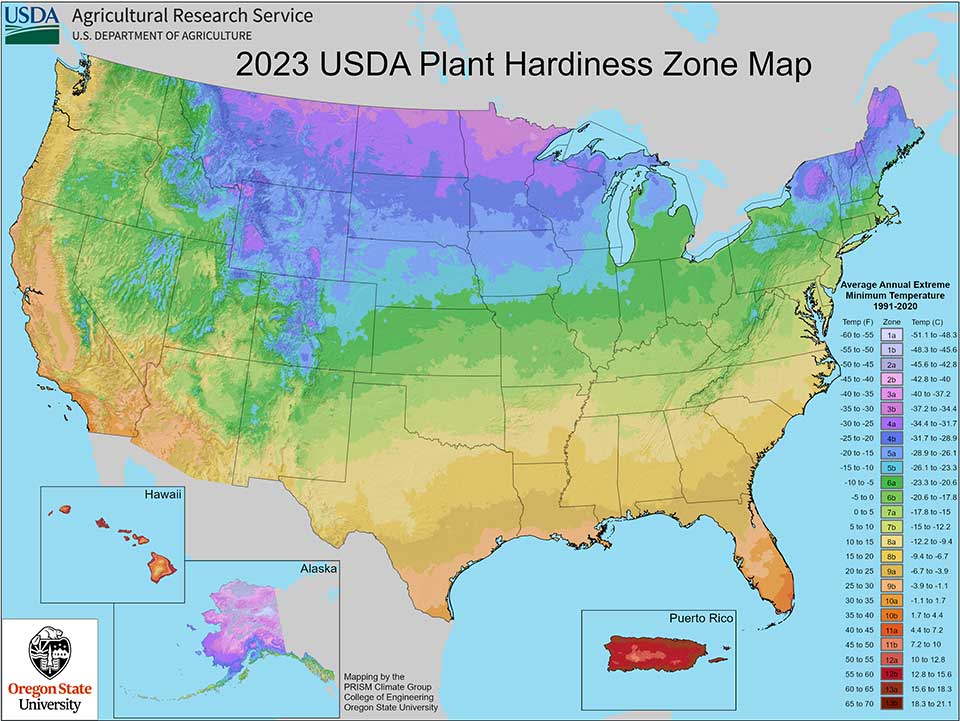If you've done any gardening, you've probably come across the USDA plant hardiness zone map. This map will often appear on the back of seed packets, or in the information you find about different plants in seed and nursery catalogs. You may have wondered about the importance of this map and how it can be useful to you when planning your garden.
In November of 2023, the USDA plant hardiness zone map was updated for the first time since 2012. The updated version of the map is based on the 30-year averages of the lowest winter temperatures in specific locations. Some of the biggest changes in the new map are seen in the south-central and south-eastern parts of the United States. States like North Carolina, South Carolina, Georgia, Alabama, and Mississippi have locations within the states that have completely changed hardiness zone designation due to increases in average temperature. You can also see much of the midwest that was previously designated with the cooler zone of 5b has moved into zones 6a and 6b.

The planting zone map geographically defines areas based on minimum winter temperatures. This can be used to determine the length of your growing season and help you decide on what types of plants you can successfully grow. The map can also determine whether a plant will be an annual or a perennial depending on whether or not it will survive through the winter or have to be replanted because it will die in the cold.
The USDA hardiness zone map is divided into 13 major planting zones based on increments of 10 degrees Fahrenheit. Each zone is subdivided into an “A” and “B” zone separated by 5 degrees Fahrenheit. The continental United States comprises Zones 3 through 10. Alaska spans Zones 1 through 7. Hawaii and Puerto Rico span Zones 9 through 13.
Winter temperatures aren't the only thing to consider when it comes to garden planning. One of the most important factors to pay attention to is the frost dates. This will determine the length of your growing season and be especially important for vegetables and fruit. The average length of the growing season by zone is as follows:
|
Zone |
Growing Season |
|
1 |
About 100 days |
|
2 |
About 115 days |
|
3 |
About 135 days |
|
4 |
About 160 days |
|
5 |
About 195 days |
|
6 |
About 210 days |
|
7 |
About 230 days |
|
8 |
About 260 days |
|
9 |
About 310 days |
|
10-13 |
Year ‘Round |
You can get your specific dates by using the calculator on a site like Almanac.com to search by your specific zip code. The last frost date is significant when it comes time to start your seeds, whether it be indoors or outdoors. The first frost date will affect whether or not you will have time to grow something from seed to harvest. For example, watermelons typically take 5 to 9 days to germinate and then need a growing season in soil with minimum temperatures of 70 degrees Fahrenheit for 90 days to be fully mature. If you live in Zones 1 through 3, you may not be able to grow watermelon. You can use things like row covers, hoop houses, and cold frames to extend your growing season, allowing you to start seeds earlier in cold temperatures and keep plants growing through cold snaps.
There are other important factors to consider when planning your garden. You also need to take into account water, length of daylight, soil pH, heat, and humidity. You should also be aware of microclimates within your zone. You may be in a location that gets more rain or hotter summer days than an area even just a couple of miles away. Only you really know your garden best. The planting zone map and frost dates are helpful, but use your experience with your location to make the best planting decisions.
























